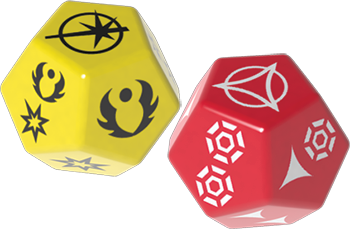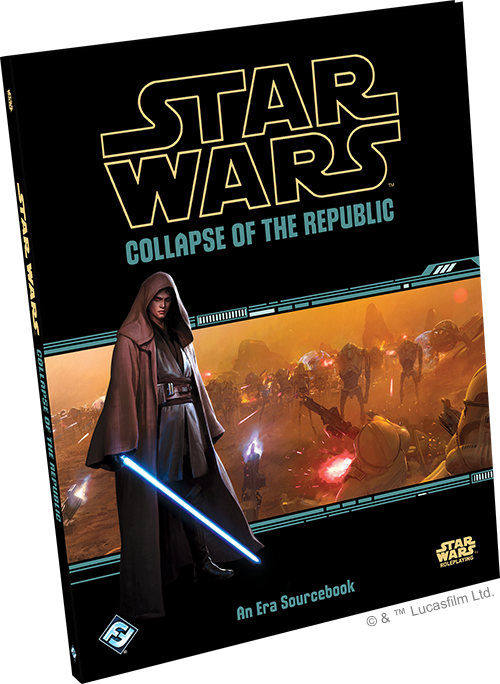
I was quite pleased and more than a little shocked when I got home to find a new book waiting for me – my copy of Fantasy Flight Games’ Collapse of the Republic for the Star Wars Narrative Dice System, especially as I wasn’t expecting it until the later part of next week.
This is the third era sourcebook for the line and the second one to deal with the Clone Wars. Whereas the recently released Rise of the Separatists dealt with the prelude to and the early days of the conflict, Collapse of the Republic details the latter half and immediate aftermath. Opening with a foreward from the one and only Sam Witwer, there’s enough in here to give players and GMs a wide range of adventures and really explore the latter half of the Clone Wars and the effect it has on the galaxy.
 The book introduces four new species choices for players – the Clone, the Dathomirian, the spider-like Harch, and the Karkarodan. It also includes a number of new specializations for the careers that were introduced in Rise of the Separatists – the Clone Soldier and the Jedi. The Clone Soldier sees the ARC Trooper, Clone Commander, and Clone Veteran trees. Clone Commander builds impressively off of the Clone Officer tree from Rise with little in the way of talent overlap much the same as the Clone Veteran builds off of the Clone Trooper tree. The Jedi gets the General and Master trees which require a Force Rating of 2 and 3 to buy into respectively – it’s an interesting tactic, and one that I think a lot of players were expecting when this game was first being tested. Both the Clone Soldier and Jedi careers also get signature abilities in this book as well which was nice to see. The Clone Soldier gets Unmatched Teamwork which lets them do some straight up ridiculous things through the assist action. The Jedi get Peerless Interception which gives an incredible shot to their already impressive Parry and Reflect abilities.
The book introduces four new species choices for players – the Clone, the Dathomirian, the spider-like Harch, and the Karkarodan. It also includes a number of new specializations for the careers that were introduced in Rise of the Separatists – the Clone Soldier and the Jedi. The Clone Soldier sees the ARC Trooper, Clone Commander, and Clone Veteran trees. Clone Commander builds impressively off of the Clone Officer tree from Rise with little in the way of talent overlap much the same as the Clone Veteran builds off of the Clone Trooper tree. The Jedi gets the General and Master trees which require a Force Rating of 2 and 3 to buy into respectively – it’s an interesting tactic, and one that I think a lot of players were expecting when this game was first being tested. Both the Clone Soldier and Jedi careers also get signature abilities in this book as well which was nice to see. The Clone Soldier gets Unmatched Teamwork which lets them do some straight up ridiculous things through the assist action. The Jedi get Peerless Interception which gives an incredible shot to their already impressive Parry and Reflect abilities.
Finally, chapter one closes with four new Universal specializations – the Death Watch Warrior which has some interesting talents that play with jetpacks. The Nightsister tree is the first tree I’ve seen that offers a single point of Force Rating for a mere 5 XP (!) with their Witchcraft talent, though it’s important to note that the class doesn’t get the free point of Force Rating for going into it and the talent has no effect if you already have a Force Rating of 1 or higher. This does look to be an interesting specialization to explore further and has some fun abilities tied into the ichor mists of Dathomir. The Senator gets points for one of the best named talents in the game, Blather which lets them make a Charm or Deception check to Disorient enemies. Finally, the Separatist Commander rounds things out with a tree that really shines with NPC droids to lead in battle.
Chapter two does its usual thing of introducing new equipment for the PCs to play around with – weapons, armor, equipment modifications, and vehicles. There’s a few fun new toys in here such as the Amplifying Chamber that fully upgraded can give a blaster weapon Blast 9 and the wrist mounted Whipcord Thrower as made (in)famous by Cad Bane.
Chapter three describes the state of affairs of the galaxy in the latter half of the Clone Wars, describing how both the Republic and the CIS have been changed by the conflict as well as introducing some major NPCs like Ahsoka Tano, Anakin Skywalker, and Admiral Trench. It also talks about other factions that have risen to prominence during the war such as bounty hunters Cad Bane and Aurra Sing as well as the underworld machinations of Maul and Savage Oppress. Oppress’s stat block gets particular points from me for being able to tank lightsaber attacks – dude has a Soak Value of 9! The chapter closes with some gazetteer entries on some of the important worlds in the galaxy, highlighting some important places, battles and events, and introducing a modular encounter that can take place in the world.
The book closes with Chapter four, exploring how to run games set in this time frame of the Clone Wars, encouraging heroic-level play (Knight level play from Force and Destiny renamed) and exploring some ideas on how to make the death an impactful force without it being disruptive to the game – there’s some good advice in that section regardless of what kind of game you’re playing or what system you’re running. It also asks some important questions on how you handle betrayals. More specifically it explores how you handle possibly the biggest betrayal of all, Order 66, in your game? After all, you’ll probably have Clone and Jedi heroes in the same party, so it’s important to understand that this issue might come up depending on how your campaign runs. The chapter closes with a reprint of the Mass Combat rules and introduces some new stat blocks to populate your games with including Nightsisters, Death Watch Commandos, Trandoshan Mercs and some new droids, most notably (to me) the Assassin Probe Droid that was used in an attempt to assassinate Duchess Satine.
Collapse of the Republic, along with Rise of the Separatists gives GMs an incredible wealth of material to run a game set in the Clone Wars or in the time immediately before or after it. The echoes of the conflict still ring through the galaxy 20 years later in the original trilogy, so you’ll likely find some inspiration in this book regardless of when you set your game. As always, the book is worth the price of admission in content and quality alone and par for the course, there is some amazing artwork for you to salivate over.
